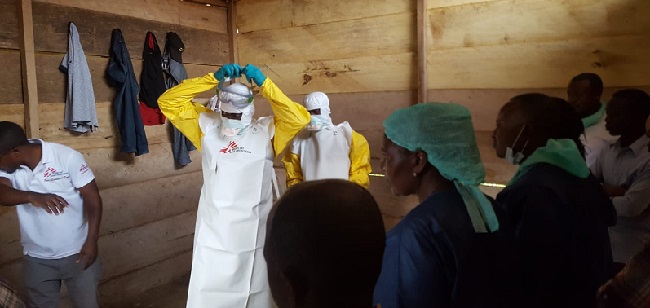Language lessons of the 2014 Ebola epidemic

Ebola treatment center in North Kivu, DR Congo. Photo: Sylvie Michaud/MSF
August 2014 was a scary time in West Africa. Ebola was spreading rapidly and the international community was waking up to a disaster that ultimately killed more than 11,000 people, writes Aimee Ansari.
In the midst of the epidemic, UNICEF and Catholic Relief Services published ominous survey results: In Sierra Leone, one of the hardest-hit countries, 30 percent of respondents believed Ebola was transmitted by mosquitoes; another 30 percent believed it was an airborne disease. Moreover, four out of 10 respondents (42 percent) believed hot salt-water baths were an effective cure.
Many reports evaluating how different agencies responded to the epidemic pointed to a lack of community engagement or understanding of local culture as key early failures. A big part of that failure was the inability of aid workers to converse in local languages.
In the three most affected countries – Guinea, Liberia, and Sierra Leone – people speak more than 90 languages. Literacy levels are low, especially in the official national languages (French and English), and yet Ebola-related materials were mostly in written form in those languages.
This early shortage of information for non-literate people and speakers of minority languages left significant swathes of the population in deadly ignorance.
ACAPS, a non-profit specialising in research and analysis of the humanitarian sector, found that in both Liberia and Sierra Leone women died in greater numbers than men at the beginning of the outbreak, in part because they had less access to information and communication channels.
Four years on, we are again responding to Ebola outbreaks: this year there have been two in the Democratic Republic of Congo, one of the most linguistically diverse countries in the world.
In the area affected by the latest outbreak, Beni Territory, the predominant languages are Swahili, Nande, and Mbuba. There are barely any trained translators for Nande and Mbuba, languages not supported by Google Translate, Microsoft Translator, Facebook, or Amazon.
Community engagement is now a priority activity for some agencies. They write guideline documents and blogs about it, discuss local communication preferences, and make it very clear they are trying to learn the lessons of the past. Maps showing what languages are spoken where have proved useful to organisations working to curb the spread of the virus.
The organisation I work for has helped provide local health workers and at-risk populations with localised translations of critical information. The International Federation of Red Cross and Red Crescent Societies and the World Health Organisation are coordinating closely with local organisations, national health service providers, and the DRC Red Cross to make sure people get timely information in a language and format they understand and trust.
It’s heartening to see that, even in such a complex and difficult context, aid agencies can and are trying to communicate effectively.
Still, some aid agencies rely on untrained and under-supported national staff or community leaders to interpret or translate for them. Our research in other contexts has found that even local aid workers don’t always understand what they are being asked to interpret. Comprehension rates among those carrying out field questionnaires, for example, are as low at 35 percent in some places.
Too often responders use a national language or regional lingua franca (such as Swahili), assuming, sometimes incorrectly, that everyone will understand.
Weak data on the languages people speak and understand means there is no evidence base for developing effective communication strategies. Language support is often absent from humanitarian budgets and programme plans, which leads to a lack of high-quality translation and interpreting services and an inability to mobilise such services early on in a response.
Think of language as a factor of vulnerability: it intersects with everything we do. Meaningful two-way communication fulfils a vital function in an emergency response, as pivotal as providing food, water, or health services.
To keep themselves and their families safe, people need critical information in a language they understand, such as, in the case of Ebola, how to best wash their hands or bury their loved ones. To be effective and accountable, responders need to be able to understand the needs and concerns of affected people.
Aimee Ansari is executive director of Translators without Borders
IRIN

